A Paternal Fish Oil Diet Preconception Reduces Lung Inflammation in a Toxicant-Driven Murine Model of New Bronchopulmonary Dysplasia
Abstract
1. Introduction
2. Results
2.1. A Paternal Fish Oil Diet Reduced the Risk of Lung Hemorrhaging and Edema in F2TCDD Pups
2.2. A Paternal Fish Oil Diet Preconception Reduced Pulmonary Expression of Toxicant and Formula Driven Pro-Inflammatory Mediators in F2TCDD Pups
2.3. Impact of Paternal and Neonatal Diet on Pulmonary Fibrosis in F2 Neonates
3. Discussion
4. Materials and Methods
4.1. Animals
4.2. Chemicals
4.3. Exposure, Mating and Diet Scheme
4.4. Diet and Mating Scheme for the F1 Generation
4.5. Formula Feeding
4.6. Euthanasia and Sample Collection
4.7. qRT-PCR
4.8. Masson’s Trichrome Stain
4.9. Lung Hemorrhaging and Edema Analysis
4.10. Immunohistochemistry
4.11. Statistics
Supplementary Materials
Author Contributions
Funding
Data Availability Statement
Acknowledgments
Conflicts of Interest
References
- Villamor-Martínez, E.; Pierro, M.; Cavallaro, G.; Mosca, F.; Villamor, E. Mother’s Own Milk and Bronchopulmonary Dysplasia: A Systematic Review and Meta-Analysis. Front. Pediatr. 2019, 7, 224. [Google Scholar] [CrossRef]
- D’Angio, C.T.; Maniscalco, W.M. Bronchopulmonary dysplasia in preterm infants: Pathophysiology and management strategies. Paediatr. Drugs 2004, 6, 303–330. [Google Scholar] [CrossRef]
- Kramer, B.W. Antenatal inflammation and lung injury: Prenatal origin of neonatal disease. J. Perinatol. 2008, 28 (Suppl. 1), S21–S27. [Google Scholar] [CrossRef]
- Singh, S.P.; Chand, H.S.; Langley, R.J.; Mishra, N.; Barrett, T.; Rudolph, K.; Tellez, C.; Filipczak, P.T.; Belinsky, S.; Saeed, A.I.; et al. Gestational Exposure to Sidestream (Secondhand) Cigarette Smoke Promotes Transgenerational Epigenetic Transmission of Exacerbated Allergic Asthma and Bronchopulmonary Dysplasia. J. Immunol. 2017, 198, 3815–3822. [Google Scholar] [CrossRef]
- Singh, S.P.; Gundavarapu, S.; Smith, K.R.; Chand, H.S.; Saeed, A.I.; Mishra, N.C.; Hutt, J.; Barrett, E.G.; Husain, M.; Harrod, K.S.; et al. Gestational exposure of mice to secondhand cigarette smoke causes bronchopulmonary dysplasia blocked by the nicotinic receptor antagonist mecamylamine. Environ. Health Perspect. 2013, 121, 957–964. [Google Scholar] [CrossRef] [PubMed]
- Ding, T.; Mokshagundam, S.; Rinaudo, P.F.; Osteen, K.G.; Bruner-Tran, K.L. Paternal developmental toxicant exposure is associated with epigenetic modulation of sperm and placental Pgr and Igf2 in a mouse model. Biol. Reprod. 2018, 99, 864–876. [Google Scholar] [CrossRef]
- Ding, T.; McConaha, M.; Boyd, K.L.; Osteen, K.G.; Bruner-Tran, K.L. Developmental dioxin exposure of either parent is associated with an increased risk of preterm birth in adult mice. Reprod. Toxicol. 2011, 31, 351–358. [Google Scholar] [CrossRef]
- McConaha, M.E.; Ding, T.; Lucas, J.A.; Arosh, J.A.; Osteen, K.G.; Bruner-Tran, K.L. Preconception omega-3 fatty acid supplementation of adult male mice with a history of developmental 2,3,7,8-tetrachlorodibenzo-p-dioxin exposure prevents preterm birth in unexposed female partners. Reproduction 2011, 142, 235–241. [Google Scholar] [CrossRef] [PubMed]
- Rumph, J.T.; Rayford, K.J.; Stephens, V.R.; Ameli, S.; Nde, P.N.; Osteen, K.G.; Bruner-Tran, K.L. A Preconception Paternal Fish Oil Diet Prevents Toxicant-Driven New Bronchopulmonary Dysplasia in Neonatal Mice. Toxics 2021, 10, 7. [Google Scholar] [CrossRef] [PubMed]
- Mokshagundam, S.; Ding, T.; Rumph, J.T.; Dallas, M.; Stephens, V.R.; Osteen, K.G.; Bruner-Tran, K.L. Developmental 2,3,7,8-tetrachlorodibenzo-p-dioxin exposure of either parent enhances the risk of necrotizing enterocolitis in neonatal mice. Birth Defects Res. 2020, 112, 1209–1223. [Google Scholar] [CrossRef]
- Baier, R.J.; Kruger, T.E.; Majid, A.; Loggins, J.; Brown, E.G. Pulmonary Hemorrhage (PH) Is Associated with Increased Tracheal Concentrations of Pro-Inflammatory Cytokines and Increased Risk of Bronchopulmonary Dysplasia (BPD). Pediatr. Res. 1999, 45, 295. [Google Scholar] [CrossRef]
- Gien, J.; Kinsella, J.P. Pathogenesis and treatment of bronchopulmonary dysplasia. Curr. Opin. Pediatr. 2011, 23, 305–313. [Google Scholar] [CrossRef] [PubMed]
- Baybutt, R.C.; Rosales, C.; Brady, H.; Molteni, A. Dietary fish oil protects against lung and liver inflammation and fibrosis in monocrotaline treated rats. Toxicology 2002, 175, 1–13. [Google Scholar] [CrossRef]
- Yang, R.; Harris, W.S.; Vernon, K.; Thomas, A.M.; Qureshi, N.; Morrison, D.C.; Van Way, C.W., 3rd. Prefeeding with omega-3 fatty acids suppresses inflammation following hemorrhagic shock. JPEN J. Parenter. Enteral. Nutr. 2010, 34, 496–502. [Google Scholar] [CrossRef] [PubMed]
- Nandivada, P.; Anez-Bustillos, L.; O’Loughlin, A.A.; Mitchell, P.D.; Baker, M.A.; Dao, D.T.; Fell, G.L.; Potemkin, A.K.; Gura, K.M.; Neufeld, E.J.; et al. Risk of post-procedural bleeding in children on intravenous fish oil. Am. J. Surg. 2017, 214, 733–737. [Google Scholar] [CrossRef] [PubMed]
- Mack, M. Inflammation and fibrosis. Matrix Biol. 2018, 68–69, 106–121. [Google Scholar] [CrossRef] [PubMed]
- Mosca, F.; Colnaghi, M.; Fumagalli, M. BPD: Old and new problems. J. Matern. Fetal Neonatal Med. 2011, 24 (Suppl. 1), 80–82. [Google Scholar] [CrossRef]
- Lombardo, G.A.G.; Tamburino, S.; Magano, K.; Fagone, P.; Mammana, S.; Cavalli, E.; Basile, M.S.; Salvatorelli, L.; Catalano, F.; Magro, G.; et al. The Effect of Omega-3 Fatty Acids on Capsular Tissue around the Breast Implants. Plast. Reconstr. Surg. 2020, 145, 701–710. [Google Scholar] [CrossRef]
- Kim, J.S.; Steffen, B.T.; Podolanczuk, A.J.; Kawut, S.M.; Noth, I.; Raghu, G.; Michos, E.D.; Hoffman, E.A.; Axelsson, G.T.; Gudmundsson, G.; et al. Associations of ω-3 Fatty Acids With Interstitial Lung Disease and Lung Imaging Abnormalities Among Adults. Am. J. Epidemiol. 2021, 190, 95–108. [Google Scholar] [CrossRef]
- Oliver, C.; Watson, H. Omega-3 fatty acids for cystic fibrosis. Cochrane Database Syst. Rev. 2016, 2016, Cd002201. [Google Scholar] [CrossRef]
- Lee, S.H.; Choi, C.W. The protective effect of CXC chemokine receptor 2 antagonist on experimental bronchopulmonary dysplasia induced by postnatal systemic inflammation. Clin. Exp. Pediatr. 2021, 64, 37–43. [Google Scholar] [CrossRef] [PubMed]
- Konrad, F.M.; Reutershan, J. CXCR2 in acute lung injury. Mediat. Inflamm. 2012, 2012, 740987. [Google Scholar] [CrossRef] [PubMed]
- Lazaar, A.L.; Miller, B.E.; Donald, A.C.; Keeley, T.; Ambery, C.; Russell, J.; Watz, H.; Tal-Singer, R.; Bardin, P.; Bremner, P.; et al. CXCR2 antagonist for patients with chronic obstructive pulmonary disease with chronic mucus hypersecretion: A phase 2b trial. Respir. Res. 2020, 21, 149. [Google Scholar] [CrossRef]
- Neamah, W.H.; Busbee, P.B.; Alghetaa, H.; Abdulla, O.A.; Nagarkatti, M.; Nagarkatti, P. AhR Activation Leads to Alterations in the Gut Microbiome with Consequent Effect on Induction of Myeloid Derived Suppressor Cells in a CXCR2-Dependent Manner. Int. J. Mol. Sci. 2020, 21, 9613. [Google Scholar] [CrossRef] [PubMed]
- Hogmalm, A.; Bäckström, E.; Bry, M.; Lappalainen, U.; Lukkarinen, H.P.; Bry, K. Role of CXC chemokine receptor-2 in a murine model of bronchopulmonary dysplasia. Am. J. Respir. Cell Mol. Biol. 2012, 47, 746–758. [Google Scholar] [CrossRef]
- Lee, P.Y.; Kumagai, Y.; Xu, Y.; Li, Y.; Barker, T.; Liu, C.; Sobel, E.S.; Takeuchi, O.; Akira, S.; Satoh, M.; et al. IL-1α Modulates Neutrophil Recruitment in Chronic Inflammation Induced by Hydrocarbon Oil. J. Immunol. 2011, 186, 1747–1754. [Google Scholar] [CrossRef]
- Willis, K.A.; Ambalavanan, N. Necrotizing enterocolitis and the gut-lung axis. Semin. Perinatol. 2021, 45, 151454. [Google Scholar] [CrossRef]
- Jia, H.; Sodhi, C.P.; Yamaguchi, Y.; Lu, P.; Martin, L.Y.; Good, M.; Zhou, Q.; Sung, J.; Fulton, W.B.; Nino, D.F.; et al. Pulmonary Epithelial TLR4 Activation Leads to Lung Injury in Neonatal Necrotizing Enterocolitis. J. Immunol. 2016, 197, 859–871. [Google Scholar] [CrossRef]
- Townsley, M.I. Structure and composition of pulmonary arteries, capillaries, and veins. Compr. Physiol. 2012, 2, 675–709. [Google Scholar] [CrossRef]
- Wang, S.H.; Tsao, P.N. Phenotypes of Bronchopulmonary Dysplasia. Int. J. Mol. Sci. 2020, 21, 6112. [Google Scholar] [CrossRef]
- Morrow, L.A.; Wagner, B.D.; Ingram, D.A.; Poindexter, B.B.; Schibler, K.; Cotten, C.M.; Dagle, J.; Sontag, M.K.; Mourani, P.M.; Abman, S.H. Antenatal Determinants of Bronchopulmonary Dysplasia and Late Respiratory Disease in Preterm Infants. Am. J. Respir. Crit. Care Med. 2017, 196, 364–374. [Google Scholar] [CrossRef]
- Herrero, R.; Sanchez, G.; Lorente, J.A. New insights into the mechanisms of pulmonary edema in acute lung injury. Ann. Transl. Med. 2017, 6, 11. [Google Scholar] [CrossRef] [PubMed]
- Tracy, M.C.; Cornfield, D.N. Bronchopulmonary Dysplasia: Then, Now, and Next. Pediatr. Allergy Immunol. Pulmonol. 2020, 33, 99–109. [Google Scholar] [CrossRef]
- Kim, H.-R.; Jung, Y.H.; Kim, B.I.; Kim, S.Y.; Choi, C.W. Differences in Comorbidities and Clinical Burden of Severe Bronchopulmonary Dysplasia Based on Disease Severity. Front. Pediatr. 2021, 9, 664033. [Google Scholar] [CrossRef]
- Michael, Z.; Spyropoulos, F.; Ghanta, S.; Christou, H. Bronchopulmonary Dysplasia: An Update of Current Pharmacologic Therapies and New Approaches. Clin. Med. Insights Pediatr. 2018, 12, 1179556518817322. [Google Scholar] [CrossRef] [PubMed]
- Malek, R.; Soufi, S. Pulmonary Edema. In StatPearls; StatPearls Publishing: Treasure Island, FL, USA, 2022. [Google Scholar]
- Goerge, T.; Ho-Tin-Noe, B.; Carbo, C.; Benarafa, C.; Remold-O’Donnell, E.; Zhao, B.Q.; Cifuni, S.M.; Wagner, D.D. Inflammation induces hemorrhage in thrombocytopenia. Blood 2008, 111, 4958–4964. [Google Scholar] [CrossRef]
- Wiig, H. Pathophysiology of tissue fluid accumulation in inflammation. J. Physiol. 2011, 589 (Pt 12), 2945–2953. [Google Scholar] [CrossRef]
- Jin, Y.; Meng, X.; Chen, B.; Liu, Y.; Nelin, L.D. Toll-like receptor 4 antagonist protects neonatal mice from hyperoxia-induced alveolar simplification. FASEB J. 2019, 33, 845–846. [Google Scholar] [CrossRef]
- Savani, R.C. Modulators of inflammation in Bronchopulmonary Dysplasia. Semin. Perinatol. 2018, 42, 459–470. [Google Scholar] [CrossRef]
- Pasha, A.B.; Chen, X.-Q.; Zhou, G.-P. Bronchopulmonary dysplasia: Pathogenesis and treatment. Exp. Ther. Med. 2018, 16, 4315–4321. [Google Scholar] [CrossRef]
- Connors, J.; Gibbs, K. Bronchopulmonary Dysplasia: A Multidisciplinary Approach to Management. Curr. Pediatr. Rep. 2019, 7, 83–89. [Google Scholar] [CrossRef]
- Calder, P.C. Omega-3 fatty acids and inflammatory processes. Nutrients 2010, 2, 355–374. [Google Scholar] [CrossRef] [PubMed]
- Calder, P.C. Marine omega-3 fatty acids and inflammatory processes: Effects, mechanisms and clinical relevance. Biochim. Biophys. Acta 2015, 1851, 469–484. [Google Scholar] [CrossRef]
- Akintoye, E.; Sethi, P.; Harris, W.S.; Thompson, P.A.; Marchioli, R.; Tavazzi, L.; Latini, R.; Pretorius, M.; Brown, N.J.; Libby, P.; et al. Fish Oil and Perioperative Bleeding. Circ. Cardiovasc. Qual. Outcomes 2018, 11, e004584. [Google Scholar] [CrossRef] [PubMed]
- Koch, T.; Duncker, H.P.; Klein, A.; Schlotzer, E.; Peskar, B.M.; van Ackern, K.; Neuhof, H. Modulation of pulmonary vascular resistance and edema formation by short-term infusion of a 10% fish oil emulsion. Infus. Transfus. 1993, 20, 291–300. [Google Scholar] [CrossRef]
- Vogel, C.F.; Zhao, Y.; Wong, P.; Young, N.F.; Matsumura, F. The use of c-src knockout mice for the identification of the main toxic signaling pathway of TCDD to induce wasting syndrome. J. Biochem. Mol. Toxicol. 2003, 17, 305–315. [Google Scholar] [CrossRef] [PubMed]
- Philip, N.; Priya, S.P.; Jumah Badawi, A.H.; Mohd Izhar, M.H.; Mohtarrudin, N.; Tengku Ibrahim, T.A.; Sekawi, Z.; Neela, V.K. Pulmonary haemorrhage as the earliest sign of severe leptospirosis in hamster model challenged with Leptospira interrogans strain HP358. PLoS Negl. Trop. Dis. 2022, 16, e0010409. [Google Scholar] [CrossRef]
- Guo, Q.; Yaron, J.R.; Wallen, J.W.; Browder, K.F.; Boyd, R.; Olson, T.L.; Burgin, M.; Ulrich, P.; Aliskevich, E.; Schutz, L.N.; et al. PEGylated Serp-1 Markedly Reduces Pristane-Induced Experimental Diffuse Alveolar Hemorrhage, Altering uPAR Distribution, and Macrophage Invasion. Front. Cardiovasc. Med. 2021, 8, 633212. [Google Scholar] [CrossRef]
- Parker, J.C.; Townsley, M.I. Evaluation of lung injury in rats and mice. Am. J. Physiol. Lung Cell. Mol. Physiol. 2004, 286, L231–L246. [Google Scholar] [CrossRef]
- Matsuyama, H.; Amaya, F.; Hashimoto, S.; Ueno, H.; Beppu, S.; Mizuta, M.; Shime, N.; Ishizaka, A.; Hashimoto, S. Acute lung inflammation and ventilator-induced lung injury caused by ATP via the P2Y receptors: An experimental study. Respir. Res. 2008, 9, 79. [Google Scholar] [CrossRef]
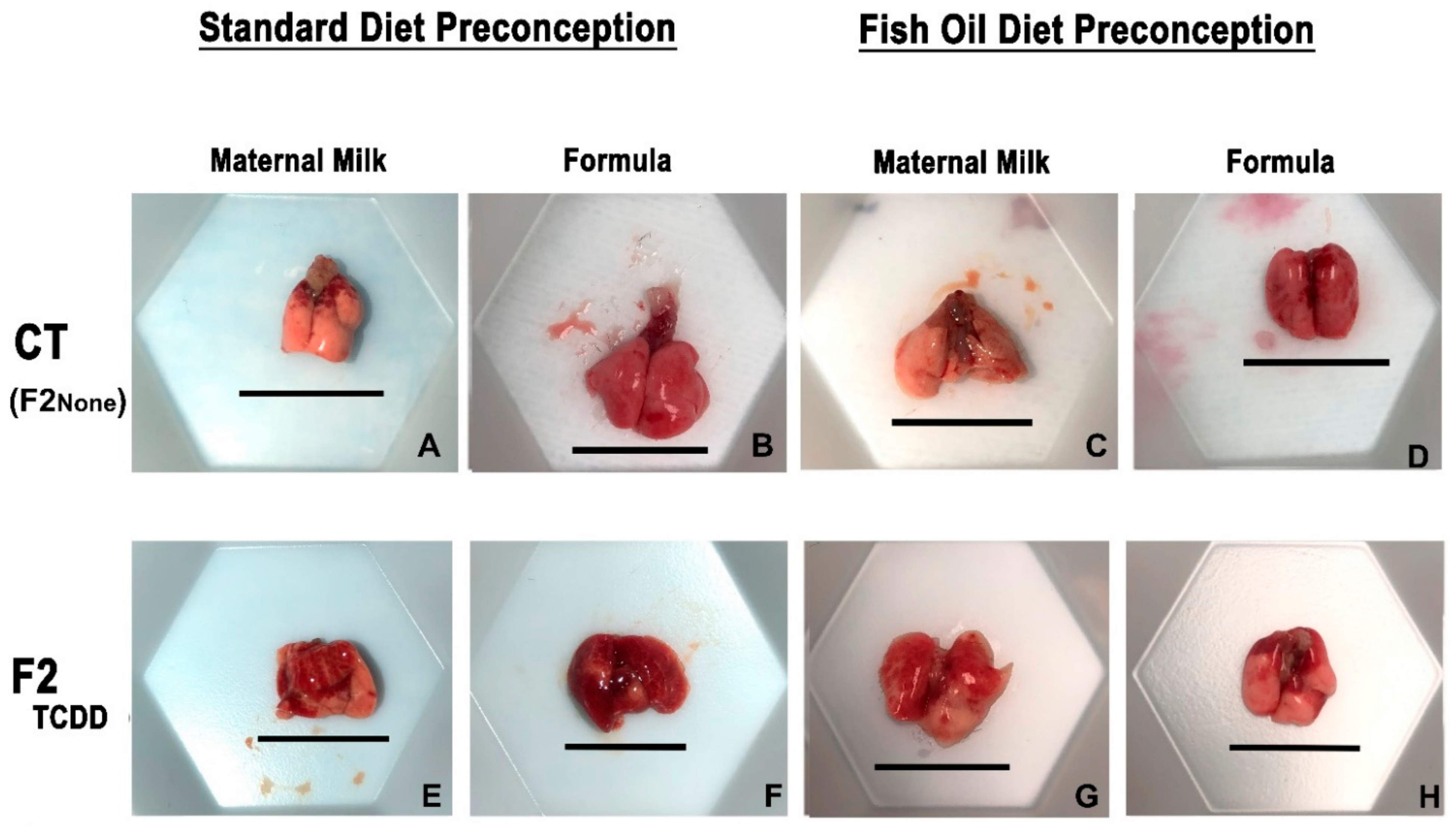
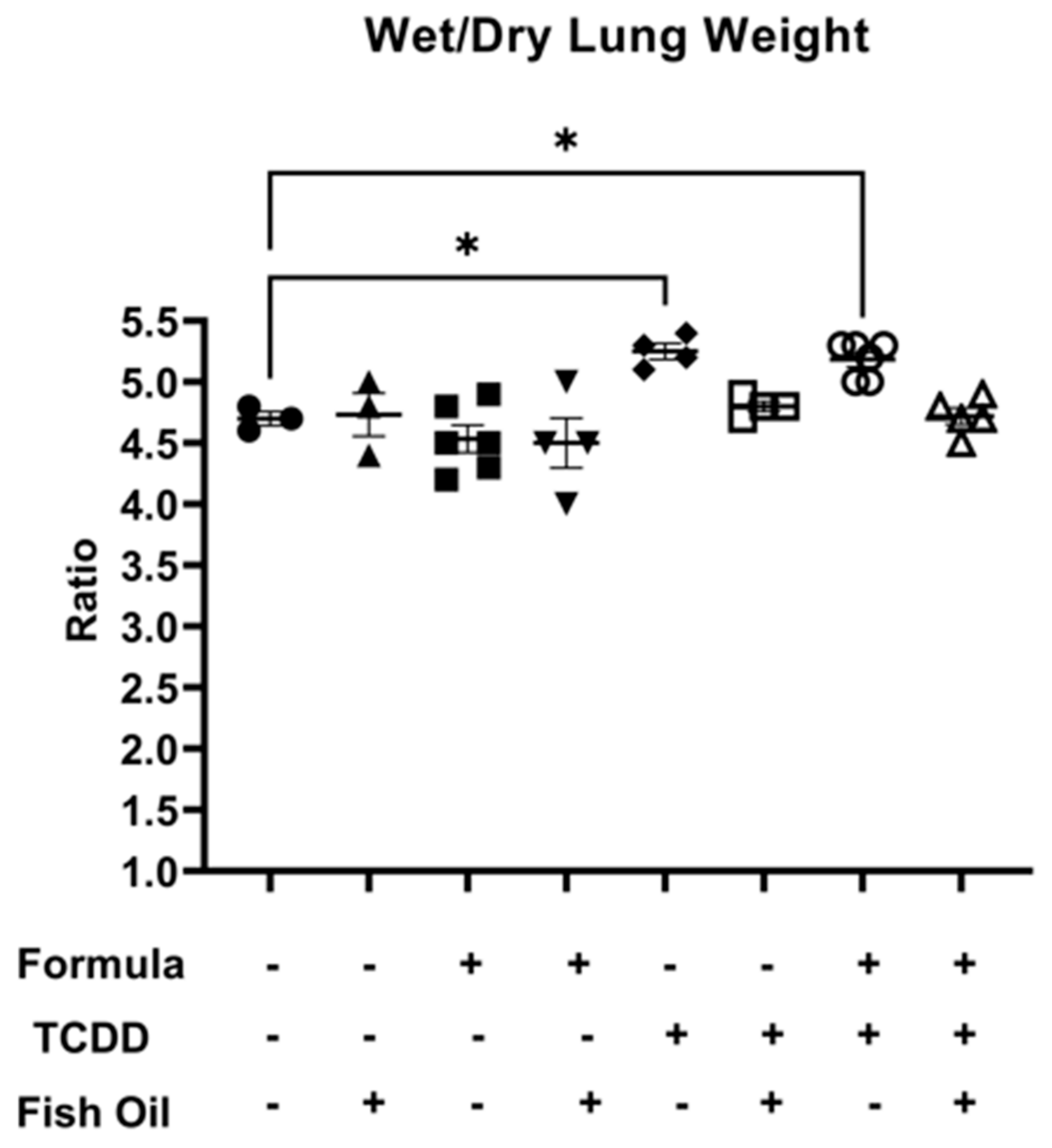
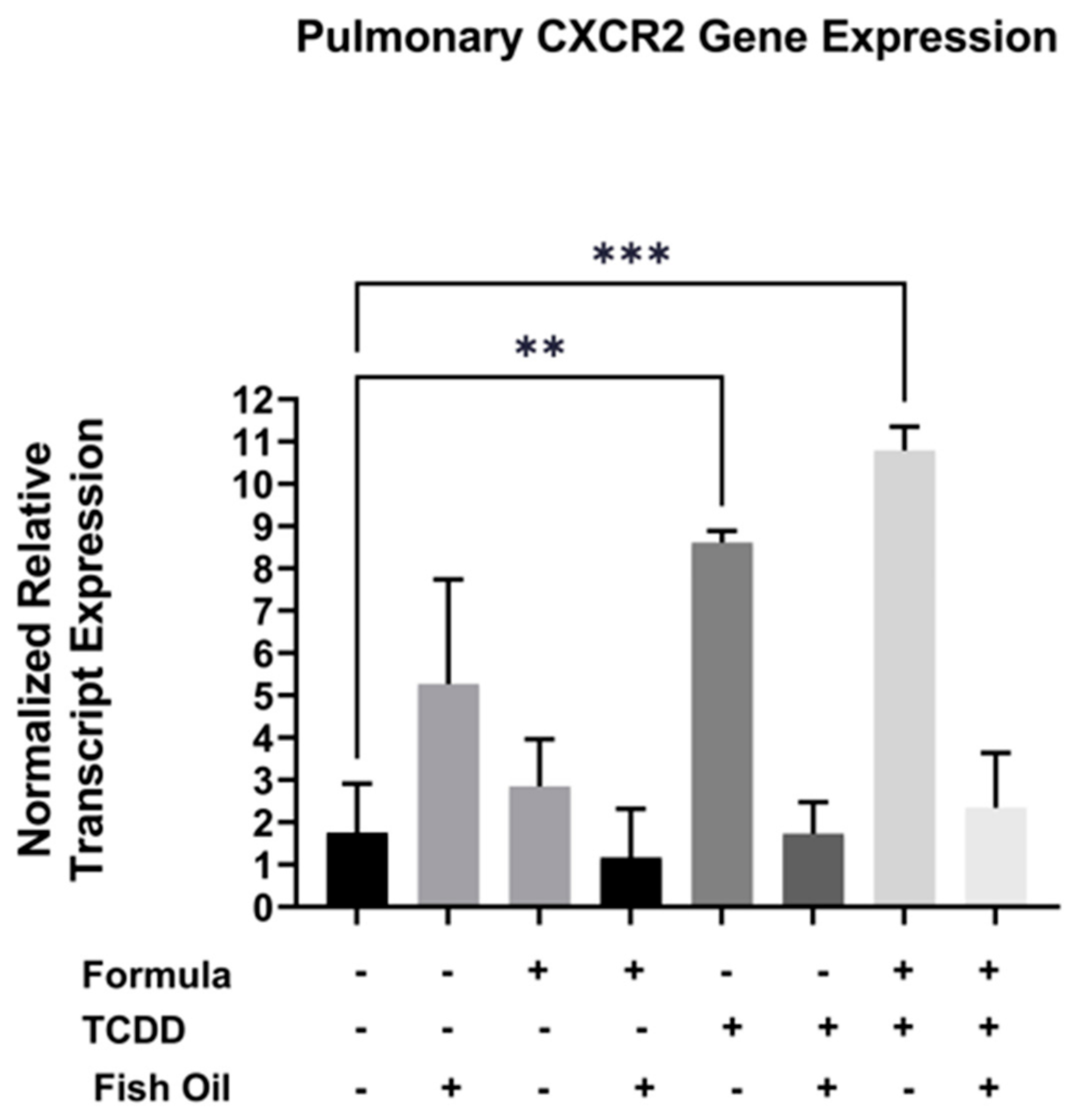
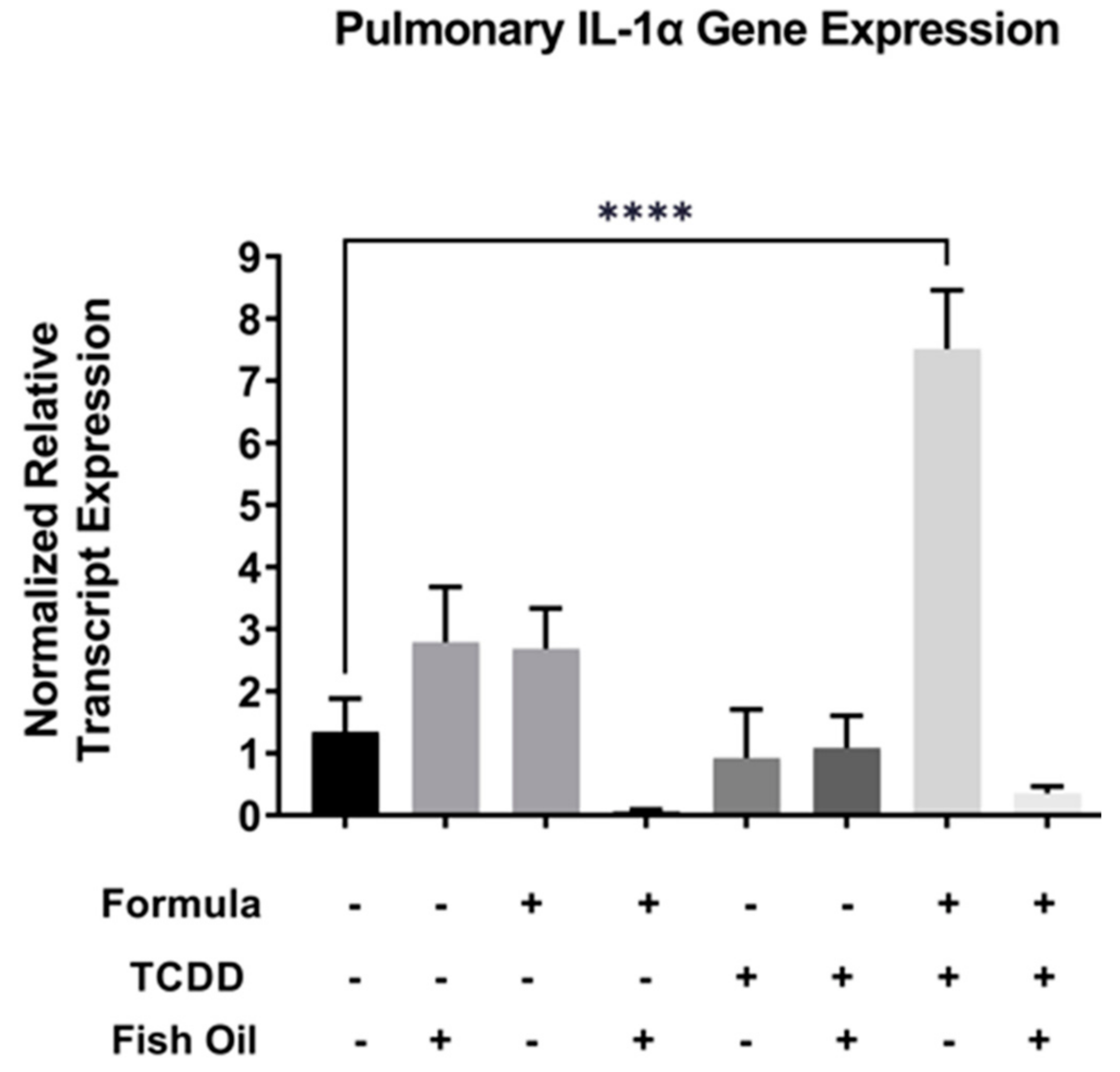
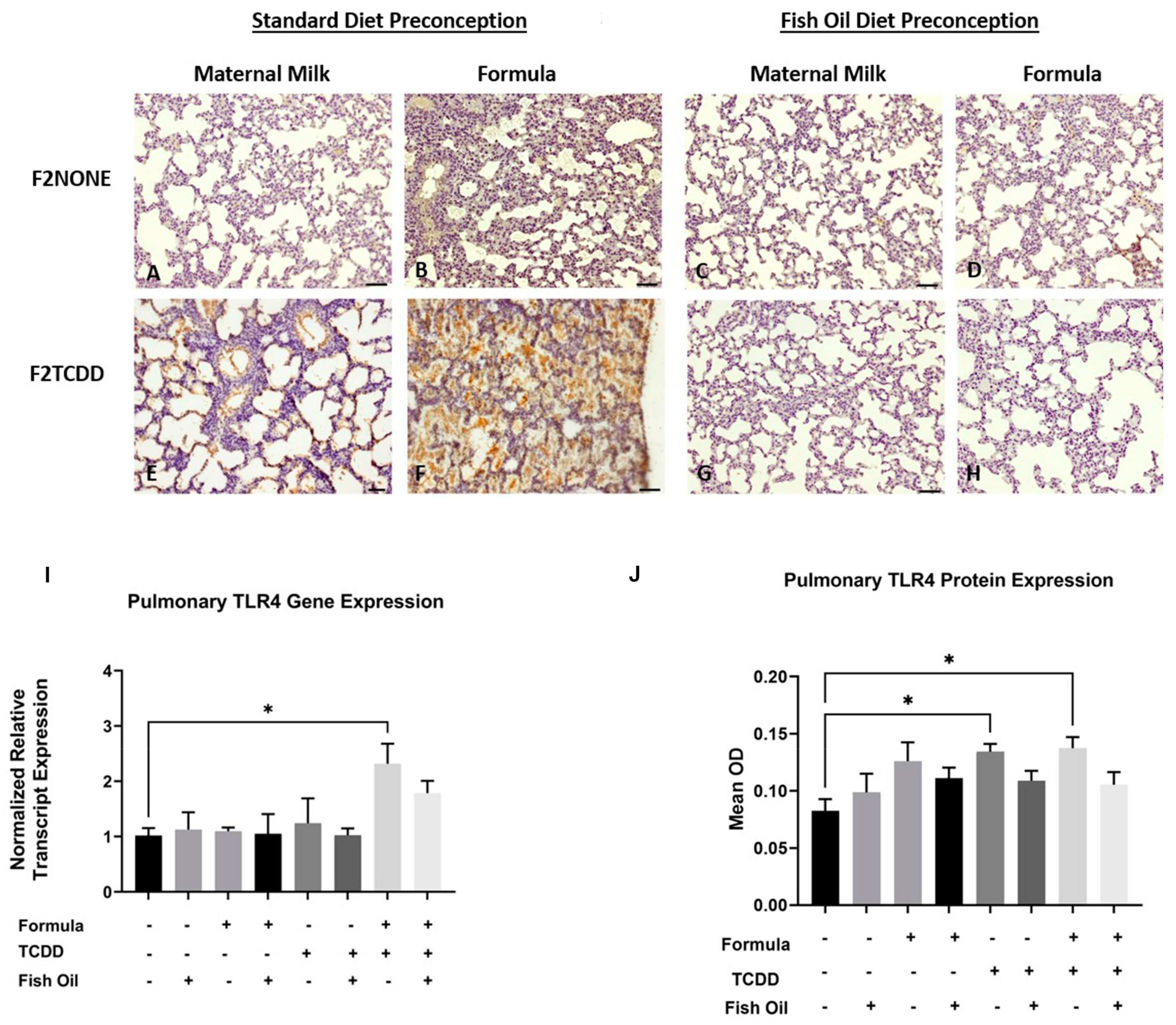

| F2 Generation Nomenclature | Was the Pup’s Father (F1 Generation) Exposed to TCDD in Utero? | Did the Pup’s Father (F1 Generation) Receive a Fish Oil Preconception Diet? | Did the Pup (F2 Generation) Receive Postnatal Formula Supplementation? |
|---|---|---|---|
| F2NONE (CT) | No | No | No |
| F2NONE/Fish (CT) | No | Yes | No |
| F2NONE/Form (CT) | No | No | Yes |
| F2 NONE/ Fish/Form (CT) | No | Yes | Yes |
| F2TCDD | Yes | No | No |
| F2TCDD/Fish | Yes | Yes | No |
| F2TCDD/Form | Yes | No | Yes |
| F2TCDD/Fish/Form | Yes | Yes | Yes |
Disclaimer/Publisher’s Note: The statements, opinions and data contained in all publications are solely those of the individual author(s) and contributor(s) and not of MDPI and/or the editor(s). MDPI and/or the editor(s) disclaim responsibility for any injury to people or property resulting from any ideas, methods, instructions or products referred to in the content. |
© 2023 by the authors. Licensee MDPI, Basel, Switzerland. This article is an open access article distributed under the terms and conditions of the Creative Commons Attribution (CC BY) license (https://creativecommons.org/licenses/by/4.0/).
Share and Cite
Rumph, J.T.; Stephens, V.R.; Ameli, S.; Brown, L.K.; Rayford, K.J.; Nde, P.N.; Osteen, K.G.; Bruner-Tran, K.L. A Paternal Fish Oil Diet Preconception Reduces Lung Inflammation in a Toxicant-Driven Murine Model of New Bronchopulmonary Dysplasia. Mar. Drugs 2023, 21, 161. https://doi.org/10.3390/md21030161
Rumph JT, Stephens VR, Ameli S, Brown LK, Rayford KJ, Nde PN, Osteen KG, Bruner-Tran KL. A Paternal Fish Oil Diet Preconception Reduces Lung Inflammation in a Toxicant-Driven Murine Model of New Bronchopulmonary Dysplasia. Marine Drugs. 2023; 21(3):161. https://doi.org/10.3390/md21030161
Chicago/Turabian StyleRumph, Jelonia T., Victoria R. Stephens, Sharareh Ameli, LaKendria K. Brown, Kayla J. Rayford, Pius N. Nde, Kevin G. Osteen, and Kaylon L. Bruner-Tran. 2023. "A Paternal Fish Oil Diet Preconception Reduces Lung Inflammation in a Toxicant-Driven Murine Model of New Bronchopulmonary Dysplasia" Marine Drugs 21, no. 3: 161. https://doi.org/10.3390/md21030161
APA StyleRumph, J. T., Stephens, V. R., Ameli, S., Brown, L. K., Rayford, K. J., Nde, P. N., Osteen, K. G., & Bruner-Tran, K. L. (2023). A Paternal Fish Oil Diet Preconception Reduces Lung Inflammation in a Toxicant-Driven Murine Model of New Bronchopulmonary Dysplasia. Marine Drugs, 21(3), 161. https://doi.org/10.3390/md21030161






